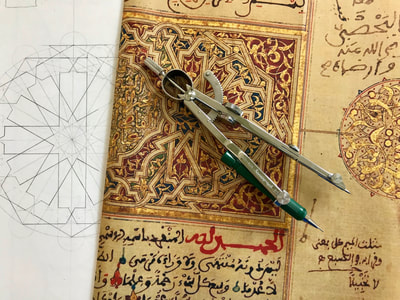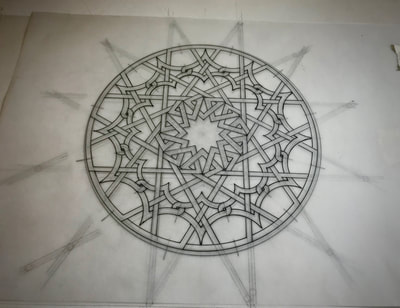|
Sharmina’s work is exciting and different. She sells her work as paintings, often inspired from tile-work or Koranic manuscripts and undertakes commissions for people who want to have something specific represented. Using gouache or watercolour (which Sharmina prefers because of the movement and depth) in the final design, Sharmina aims to ‘decode’ original geometric patterns and art. She recreates them with extreme precision, using compasses and mechanical pencils to achieve the first draft. Watching how Sharmina works you can begin to understand the enormity of the task of decoding an original ancient design. Sharmina likes to analyse historic traditional patterns and build up a design based on them. Once the design is developed it can then be painted on wood or tiles, paper, glass or on plates and pottery. Sharmina has a maths background and is naturally interested in how patterns are formed. Decoding a pattern, like the doorway of the Blue Mosque in Istanbul, was around one day’s work to prepare the original geometry. Her favourite design however, is from a manuscript which she first saw in an auction at Christies and then was fascinated into how to replicate the design. See below a series of photos which show how this particular design was built up. Sharmina uses traditional old metal compasses, not so easily available today, which have a lot of weight and are best to use for this type of detailed work. Mechanical pencils and technical pens are the best to use as you can then get the depth of detail needed. It can be time consuming and Sharmina explains how easy it is to let go and lose yourself in the patterns. Sharmina stresses the importance of making notes as she goes, in order to capture the geometrical content of the work, and builds up the design layer by layer. In some of her work she has left the geometrical pattern grids in the work so that you can see the intricacies. In other cases she will trace a final design and block in the colour. So there is an easy route for those that just want to create a sophisticated design without the decoding! For floral patterns, gouache is the more traditional finish but Sharmina often makes her own pigments from natural substances. Today, she just happened to have a box of rocks in her car! She showed me several pieces of malachite which makes a beautiful turquoise green paint. A small amount will last a long time and a 3 inch piece of rock might make about two pans worth of paint. Sharmina explains that you have to grind the rock down and then wash out the impurities, and then use a typical binding medium such as Gum Arabic, which enables it to be painted. This makes up the beautiful lapiz style paints so typical in Middle Eastern painting work. So many different shades of colour come from the different pieces of stone. We also looked at pieces of cinnabar from which Sharmina creates the common bright scarlet / brick-red from this form of mercury. Sharmina was originally inspired with the Muslim arts from childhood but travelling to Morocco and Istanbul about five years ago sparked her into the thrill of analysing a pattern and then finding out how the pattern was created. She then went on a study trip to Fez and this opened up a whole new world. She says, ‘from analysing those patterns you move easily into painting up your designs. Social media has been a big part of opening the world of Islamic art as it has a tremendous following and you get to meet so many like-minded people’.
Advice for beginners Sharmina has some great advice for beginners: "Islamic geometry is the perfect place to start as you can so easily create patterns quite quickly without the need for decoding. If that's what you enjoy then fine, but then you can go to next level and add paint and colour. You can just copy and it is very rule bound so you don't even have to be artistic. For children it’s fantastic – you can link to maths but it doesn’t have to be. The oldest designs are intriguing as you are actually using the same techniques as were used over one thousand years ago. There are no records of how things were created. but we know there were straight edges and compasses so they would have been designed in the same way then as now. Tiles are a good way of pattern making as you start with a simple square and then you create a design by putting the squares together – rotating, reflecting and repeating the patterns to create new shapes and complex designs." If you are inspired and want to try one of Sharmina’s workshops, then follow the button link below>>
0 Comments
Your comment will be posted after it is approved.
Leave a Reply. |
Blog categories
All
Author:
|












 RSS Feed
RSS Feed